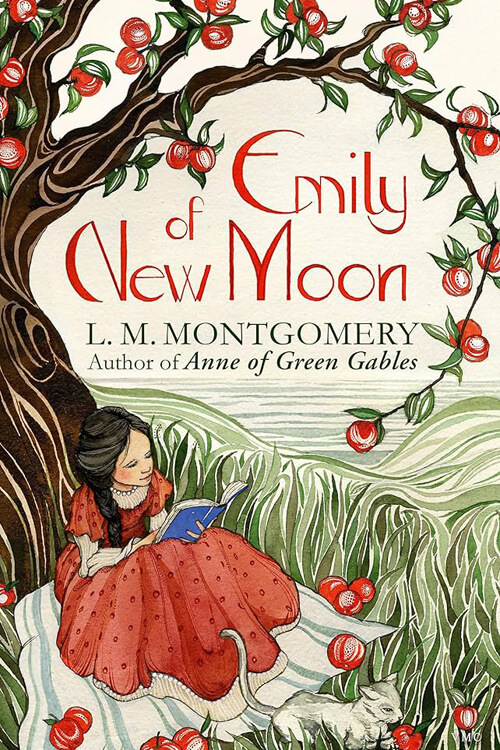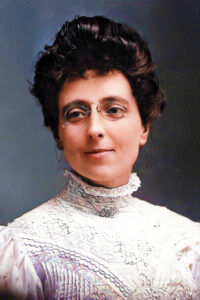
Emily of New Moon
The house in the hollow was “a mile from anywhere,” the Maywood people said. It was situated in a grassy little dale, looking like it had never been built like other houses but had grown up there like a giant, brown mushroom. It was reached by a long, green lane and almost hidden from view by an encircling growth of young birches. No other house could be seen from it, although the village was just over the hill. Ellen Greene said it was the most lonesome place in the world and vowed that she wouldn’t stay there a day if it weren’t that she pitied the child.
Emily didn’t know she was being pitied and didn’t know what lonesomeness meant. She had plenty of company. There was Father—and Mike—and Saucy Sal. The Wind Woman was always around, and there were the trees—Adam and Eve, the Rooster Pine, and all the friendly lady birches.
And there was “the flash,” too. She never knew when it might come, and the possibility of it kept her a thrill and expectant.
Emily had slipped away in the chilly twilight for a walk. She remembered that walk very vividly all her life—perhaps because of a certain eerie beauty in it—probably because “the flash” came for the first time in weeks—more likely because of what happened after she returned from it.
It had been a dull, cold day in early May, threatening to rain but never raining. Father had lain on the sitting-room lounge all day. He had coughed a good deal and had not talked much to Emily, which was very unusual for him. Most of the time, he lay with his hands clasped under his head and his large, sunken, dark-blue eyes fixed dreamily and unseeingly on the cloudy sky that was visible between the boughs of the two giant spruces in the front yard—Adam-and-Eve, they always called those spruces, because of a whimsical resemblance Emily had traced between their position, concerning a small apple-tree between them, and that of Adam and Eve and the Tree of Knowledge in an old-fashioned picture in one of Ellen Greene’s books. The Tree of Knowledge looked precisely like the squat little apple tree, and Adam and Eve stood up on either side as stiffly and rigidly as did the spruces.
Emily wondered what Father was thinking, but she never questioned him when his cough was terrible. She only wished she had somebody to talk to. Ellen Greene wouldn’t talk that day, either. She did nothing but grunt, and grunts meant that Ellen was disturbed about something. She grunted last night after the doctor whispered to her in the kitchen, and she grunted when she gave Emily a bedtime snack of bread and molasses. Emily does not like bread and molasses but eats them because she does not want to hurt Ellen’s feelings. It was not often that Ellen allowed her anything to eat before going to bed, and when she did, it meant that, for some reason or other, she wanted to confer a special favor.
Read or download Book
Lucy Maud Montgomery
Lucy Maud Montgomery OBE (November 30, 1874 – April 24, 1942), published as L. M. Montgomery, was a Canadian author best known for a collection of novels, essays, short stories, and poetry beginning in 1908 with Anne of Green Gables. She published 20 novels as well as 530 short stories, 500 poems, and 30 essays. Anne of Green Gables was an immediate success; the title character, orphan Anne Shirley, made Montgomery famous in her lifetime and gave her an international following. Most of the novels were set on Prince Edward Island, and those locations within Canada’s smallest province became a literary landmark and popular tourist site – namely Green Gables farm, the genesis of Prince Edward Island National Park. She was made an officer of the Order of the British Empire in 1935.
Montgomery’s work, diaries, and letters have been read and studied by scholars and readers worldwide. The L. M. Montgomery Institute, University of Prince Edward Island, is responsible for the scholarly inquiry into the life, works, culture, and influence of L. M. Montgomery.
Early life and education
Lucy Maud Montgomery was born in New London on Prince Edward Island, Canada, on November 30, 1874. Her mother, Clara Woolner Montgomery (1853-1876), known as “Tillie”, died of tuberculosis (TB) when Maud was 21 months old. Stricken with grief, her father, Hugh John Montgomery (1841-1900), placed Maud in her maternal grandparents’ custody, though he remained in the vicinity. When Maud was seven, her father moved to Prince Albert, North-West Territories (now Prince Albert, Saskatchewan). From then on Maud was raised by her grandparents, Alexander Marquis Macneill and Lucy Woolner Macneill, in the community of Cavendish, Prince Edward Island.
Montgomery’s early life in Cavendish was very lonely. Despite having relatives nearby, much of her childhood was spent alone. She created imaginary friends and worlds to cope with her loneliness, and Montgomery credited this time of her life with developing her creativity. Her imaginary friends were named Katie Maurice and Lucy Gray and lived in the “fairy room” behind the bookcase in the drawing room. During a church service, Montgomery asked her aunt where her dead mother was, leading her to point upwards. Montgomery saw a trap door in the church’s ceiling, which led her to wonder why the minister did not just get a ladder to retrieve her mother from the church’s ceiling.
In 1887, at age 13, Montgomery wrote in her diary that she had “early dreams of future fame.” She submitted a poem for publication, writing, “I saw myself the wonder of my schoolmates— a little local celebrity.” Upon rejection, Montgomery wrote, “Tears of disappointment would come despite me, as I crept away to hide the poor crumpled manuscript in the depths of my trunk.” She later wrote, “Down, deep down under all the discouragement and rebuff, I knew I would ‘arrive’ someday.”
After completing her education in Cavendish, Montgomery spent one year (1890) in Prince Albert with her father and her stepmother, Mary Ann McRae (1863-1910), who had married in 1887. While she was in Prince Albert, Montgomery’s first work, a poem titled “On Cape LeForce,” was published in the Charlottetown paper The Daily Patriot. She was as excited about this as she was about her return to Prince Edward Island in 1891. Before returning to Cavendish, Montgomery had another article published in the newspaper, describing her visit to a First Nations camp on the Great Plains. She often saw Blackfeet and Plains Cree in Prince Albert, writing that she saw many Indians on the Prairies who were much more handsome than those she had seen in the Maritimes.
Montgomery’s return to Cavendish was a great relief to her. Her time in Prince Albert was unhappy, for she did not get along with her stepmother. According to Montgomery, her father’s marriage was not a happy one.






